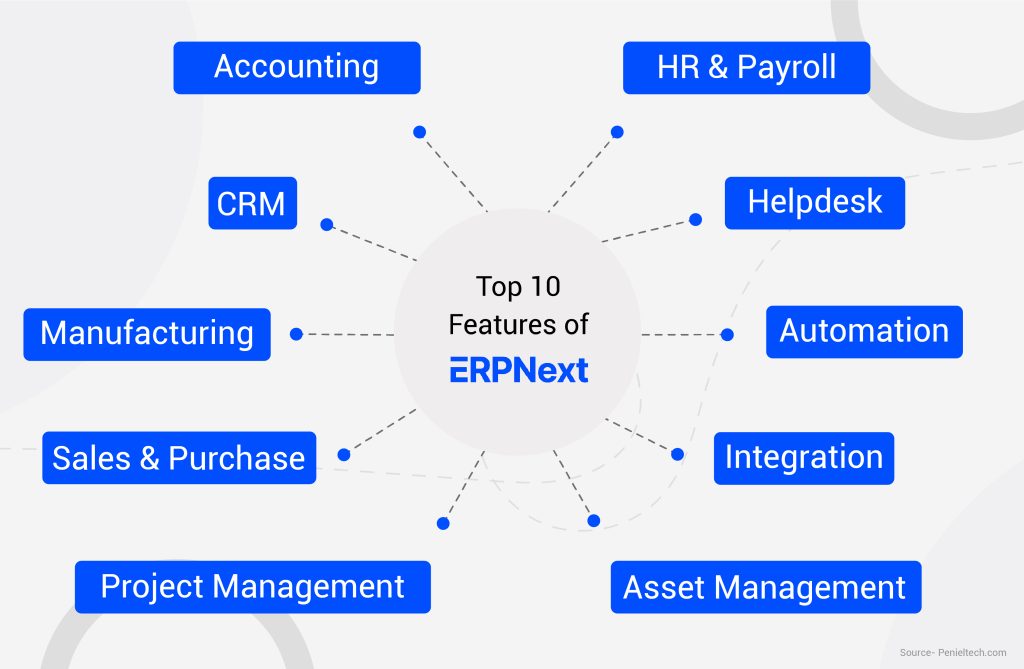What is ERPNext Software?
ERPNext is a robust, all-inclusive, user-friendly, and also reasonably priced solution.
ERPNext is an on-premise and cloud-based system that can be installed on any server or mobile device.
It is a central ERP system that helps firms manage all business workflow efficiently and effectively.
It supports more than 30 languages.
Additionally, Manufacturing, distribution, retail, services, education, health care, non-profit, agriculture, hospitality, and other industries are just a few of the business verticals for which ERPNext was developed.
ERPNext provides worldwide support for small as well as medium-sized organizations.

Top 10 features of ERPNext Software
1. Accounting
Support for many currencies is one of ERPNext’s most crucial features.
Moreover, It is an all-in-one platform that supports capabilities for bank and payment settlement, information, and tax calculation. It will oversee the entire accounting procedure.
2. HR & Payroll
The features go over the steps involved in leading a group of coworkers.
You can use it to create and handle employee payrolls and tax regulations.
You can use it to keep an exhaustive personnel database, which includes contact information, compensation information, attendance information, performance evaluation results, as well as appraisal records.
3. Manufacturing
There are many different manufacturing industries.
The management of production is quite challenging.
You must monitor your inventories, workstations, warehouse as well as production, and other factors.
ERPNext’s manufacturing tools can help you easily handle all of these operations.
With the aid of a production planning system, ERPNext enables you to schedule your inventory and also materials.
Based on the availability of Workstations, create as well as construct your production schedule. Utilize advanced capabilities for costing and a hierarchical Bill of Materials.
The ease of subcontracting or outsourcing is a step in the production process such that the cost is incorporated into the finished goods.
4. Sales & Purchase
Another benefit of ERP systems is their capacity for selling, upselling, creating bids and buy orders, forecasting, managing commissions, and monitoring vital data like profit margins and ratios.
The system gathers all critical data on sales as well as purchases.
Dashboards offer a quick peek at important performance metrics about business operations.
You can analyze every aspect of your organization at once thanks to configurable accounting dimensions and customized dashboards.
5. Customer relationship management
Managing a customer is a stressful procedure.
The secret to success is having happy customers. manually managing customers becomes time-consuming. To manage customers and keep up good customer relations, you must implement software.
CRM functions are provided by ERP. It assists in managing all client interactions and also relationships for your business.
It aids in obtaining leads that strengthen commercial ties.
Automating the procedure boosts the company’s productivity and also raises sales.
Additionally, By remaining aligned with clients, streamlining procedures, and boosting profitability, it forges strong bonds.
6. Project Management
The project management features of ERPNext help you to manage projects.
With this feature, you can establish and assign tasks for projects, as well as record time against each job in a time log.
Orders, invoicing and inventories can all be tracked against projects, and also time logs can be used to bill customers.
With this function, a progressive overview ensures that you never miss a deadline.
Additionally, By anticipating and preparing future projects, you can accurately keep track of expected deadlines.
7. Helpdesk
With the help of these capabilities, you can collect the businesses that your customers report, contact them, assign them to a team, and also keep track of their progress.
All communications are seamlessly converted into data by this function, saving your support team from having to switch between apps.
It maintains server levels and keeps track of customer tickets and issues.
With the aid of this program, you can easily transform emails in your inbox into tickets.
8. Automation
An ERP system can automate payroll, invoicing, reporting, and other repetitive business operations.
Automation speeds up data entry, lowers errors, and also frees up staff time for tasks that bring more value.
Due to the nature of ERP systems, information entered by one user is accessible to all users within the company.
So, for instance, when a specific SKU becomes available, an inventory tracking module may instantly initiate a shipment and invoice.
This results in increased income and improved customer satisfaction.
Or, to help them make decisions, line-of-business leaders may immediately receive the most recent statistics on cash flow and other metrics.
9. Integration
Integration is the process of combining software with any third-party app or software.
Moreover, ERP may communicate data between systems by integrating with any other tool.
The efficiency is increased and your workflow is streamlined by this integration capability.
Every corporation has a unique set of tasks that are necessary for the ERP software to work with specialized software and satisfy business needs.
Silos for bespoke software development firms’ sales, engineering, accounting, and also other departments are no longer functional.
10. Asset Management
With this feature of ERPNext, you have a one-stop shop for managing all of your assets, including IT infrastructure, equipment purchases, equipment disposal, and more.
You can manage your assets with ease thanks to the feature-rich experience that ERPNext offers.
You can use it to manage and keep track of actions involving assets, such as buying, selling, depreciating, moving, or doing maintenance.
It’s a useful all-in-one tool for maintaining and keeping all of your organization’s branch data in a single, centralized system.
HRMS UAE
ReplyDeleteHRMS Dubai
HRMS Software Dubai
HRMS Software UAE
HRMS Software UAE
HRMS
HRMS Software
HRMS UAE
HRMS Software Dubai
HRMS Software UAE
HRMS